Microeconomics and Macroeconomics 宏观经济与微观经济的区分以及案例分析
网络经济学名词解释

B2B(business to business):企业对企业透过电子商务的方式进行交易。
B2C(Business-to-consumer):B2C的销售方式是企业对顾客。
机会成本(opportunity costs):是指为了得到某种东西而所要放弃另一些东西的最大价值。
微观经济学(microeconomics):有时也被称为价格理论(Price Theory),主要研究个体消费者,企业,或者产业的经济行为,及其生产和收入分配。
宏观经济学(macroeconomics):宏观经济学是以国民经济总过程的活动为研究对象,因为主要考察就业总水平、国民总收入等经济总量,因此,宏观经济学也被称作就业理论或收入理论。
网络经济(Internet economics):网络经济是指建立在计算机网络基础上的生产、分配、交换和消费的经济关系。
它以信息为基础,以计算机网络为依托,以生产、分配、交换和消费网络产品为主要内容,以高科技为支持,以知识和技术创新为灵魂。
首先,从经济形态上,它是信息经济或知识经济的主要形式,又称数字经济。
网络经济是知识经济的一种具体形态,这种新的经济形态正以极快的速度影响着社会经济与人们的生活。
与传统经济相比,网络经济具有以下显著的特征:快捷性,高渗透性,自我膨胀性,边际效益递增性,外部经济性,可持续性和直接性。
信息经济(information economics):信息经济又称资讯经济,IT经济。
作为信息革命在经济领域的伟大成果的信息经济,是通过产业信息化和信息产业化两个相互联系和彼此促进的途径不断发展起来的。
所谓信息经济,是以现代信息技术等高科技为物质基础,信息产业起主导作用的,基于信息、知识、智力的一种新型经济。
知识经济(knowledge economics):是以知识为基础的经济,与农业经济、工业经济相对应的一个概念,是一种新型的富有生命力的经济形态;通俗地说就是“以知识为基础的经济”。
经济学的100 个关健词

经济学的100个关健词1.经济学(economies):研究一个社会如何利用稀缺的资源进行有价值的生产,并把生产成果在社会成员之间进行分配的科学。
2.稀缺(scarcity):相对于人类无穷的欲望,资源总是显得不足的状态。
3.效率(efficiency):社会对资源的利用达到最佳状态,没有再改进的余地,即如果不让某个社会成员的境况变差,就不能让任何其他成员的境况变得更好。
4.生产什么,如何生产,为谁生产(what,how and whom):一个经济社会面临的基本问题,也叫资源配置,社会必须就这三个问题做出选择,以实现社会福利的最大化。
5.微观经济学(microeconomics):研究微观经济主体,即单个消费者、单个厂商、单个市场的经济学分支,其核心是价格的决定。
6.宏观经济学(macroeconomics):研究一个经济总体运行的经济学分支。
7.计划经济(planned economy):由计划当局决定生产什么、如何生产、为谁生产的经济。
8.市场经济(market economy):由市场特别是价格决定生产什么、如何生产、为谁生产的经济。
9.亚当·斯密(Adam Smith,1723-1790):英国古典经济学的伟大代表,1776年出版《国民财富的性质和原因的研究》,从而创立了近代经济学体系。
提出了著名的“看不见的手”的学说。
他的其他著作包括1759年出版的《道德情操论》等。
10.边际(marginal):某个变量的微小变动,引起的其他变量的改变量。
11.总收益(total revenue):企业出售产品得到的全部货币。
12.边际收益(marginal revenue):某种活动的微小增加所增加的总收益。
13.机会成本(opportunity cost):一件事情的机会成本是把做这件事的资源用于其他事情,所能产出的最大价值。
14.均衡(equilibrium):本来是物理学上的概念,指物体受到大小相等方向相反的两个力的作用,而保持一种暂时不动的状态。
曼昆的宏观微观经济学原理

曼昆的宏观微观经济学原理
曼昆(N.Gregory Mankiw)是美国经济学家,著名的宏观经济学家之一,他的著作《宏观经济学原理》(Principles of Macroeconomics)和《微观经济学原理》(Principles of Microeconomics)是世界各地大学广泛采用的经济学教材。
《宏观经济学原理》主要涵盖了宏观经济学的基本概念和理论,包括国民收入和经济增长、通货膨胀和失业、货币和货币市场、财政政策和货币政策等内容。
该教材的特点是注重概念的清晰度和实践的应用性,结合大量的案例和实例来帮助读者理解和应用理论知识。
《微观经济学原理》主要涵盖微观经济学的基本概念和理论,包括供求关系和市场机制、消费者行为和生产者行为、价格和效率等内容。
该教材同样注重理论和实践的结合,通过案例和实例来帮助读者理解和应用微观经济学的原理。
曼昆的宏观微观经济学原理以其简明扼要、易读易懂的风格而闻名,被广泛认可为经济学入门的经典教材,并对经济学的教学和研究产生了广泛的影响。
ap经济学
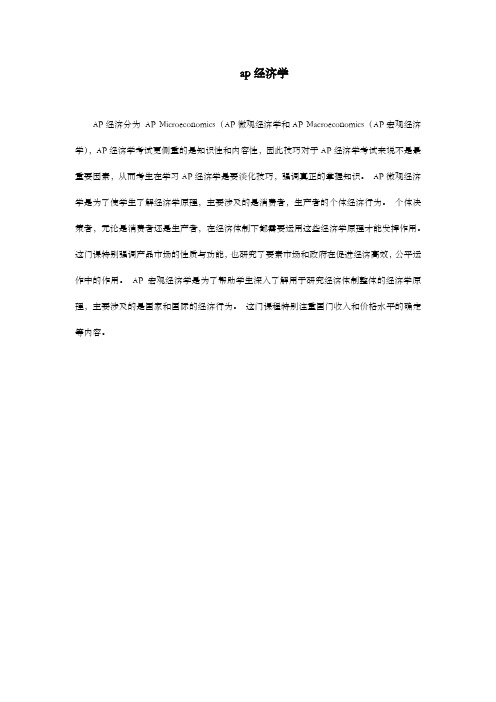
ap经济学
AP经济分为AP Microeconomics(AP微观经济学和AP Macroeconomics(AP宏观经济学),AP经济学考试更侧重的是知识性和内容性,因此技巧对于AP经济学考试来说不是最重要因素,从而考生在学习AP经济学是要淡化技巧,强调真正的掌握知识。
AP微观经济学是为了使学生了解经济学原理,主要涉及的是消费者,生产者的个体经济行为。
个体决策者,无论是消费者还是生产者,在经济体制下都需要运用这些经济学原理才能发挥作用。
这门课特别强调产品市场的性质与功能,也研究了要素市场和政府在促进经济高效,公平运作中的作用。
AP宏观经济学是为了帮助学生深入了解用于研究经济体制整体的经济学原理,主要涉及的是国家和国际的经济行为。
这门课程特别注重国门收入和价格水平的确定等内容。
经济英语知识点总结

经济英语知识点总结一、经济学基础知识1. Microeconomics(微观经济学)Microeconomics focuses on the interactions between individual buyers and sellers and the factors that influence their decisions. It examines how individuals and businesses make choices regarding the allocation of resources, production, and consumption. Key concepts in microeconomics include supply and demand, elasticity, market structures, and externalities.(微观经济学侧重研究个体买卖双方之间的互动以及影响他们决策的因素。
它研究个人和企业如何在资源分配、生产和消费方面做出选择。
微观经济学的关键概念包括供求关系、弹性、市场结构和外部性。
)2. Macroeconomics(宏观经济学)Macroeconomics looks at the overall performance of a national or global economy and the factors that influence it. It examines the behavior of major economic aggregates such as GDP, unemployment, inflation, and national income. Key concepts in macroeconomics include monetary and fiscal policy, economic growth, and international trade.(宏观经济学研究国家或全球经济的总体表现以及影响它的因素。
(完整版)《曼昆—宏观经济学》重点总结,推荐文档
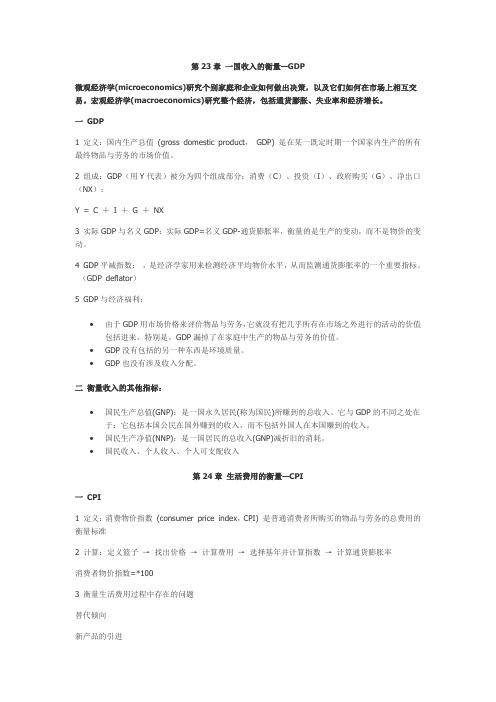
第23章一国收入的衡量—GDP微观经济学(microeconomics)研究个别家庭和企业如何做出决策,以及它们如何在市场上相互交易。
宏观经济学(macroeconomics)研究整个经济,包括通货膨胀、失业率和经济增长。
一GDP1 定义:国内生产总值(gross domestic product,GDP) 是在某一既定时期一个国家内生产的所有最终物品与劳务的市场价值。
2 组成:GDP(用Y代表)被分为四个组成部分:消费(C)、投资(I)、政府购买(G)、净出口(NX):Y = C +I +G +NX3 实际GDP与名义GDP:实际GDP=名义GDP-通货膨胀率,衡量的是生产的变动,而不是物价的变动。
4 GDP平减指数:,是经济学家用来检测经济平均物价水平,从而监测通货膨胀率的一个重要指标。
(GDP deflator)5 GDP与经济福利:•由于GDP用市场价格来评价物品与劳务,它就没有把几乎所有在市场之外进行的活动的价值包括进来,特别是,GDP漏掉了在家庭中生产的物品与劳务的价值。
•GDP没有包括的另一种东西是环境质量。
•GDP也没有涉及收入分配。
二衡量收入的其他指标:•国民生产总值(GNP):是一国永久居民(称为国民)所赚到的总收入。
它与GDP的不同之处在于:它包括本国公民在国外赚到的收入,而不包括外国人在本国赚到的收入。
•国民生产净值(NNP):是一国居民的总收入(GNP)减折旧的消耗。
•国民收入、个人收入、个人可支配收入第24章生活费用的衡量—CPI一CPI1 定义:消费物价指数(consumer price index,CPI) 是普通消费者所购买的物品与劳务的总费用的衡量标准2 计算:定义篮子→找出价格→计算费用→选择基年并计算指数→计算通货膨胀率消费者物价指数=*1003 衡量生活费用过程中存在的问题替代倾向新产品的引进无法衡量的质量变动。
4 GDP平减指数与消费者物价指数差别1:GDP平减指数反映了国内生产的所有物品与劳务的价格,而消费物价指数反交映了消费者购买的所有物品与劳务的价格。
论微观、中观、宏观经济学-2019年精选文档
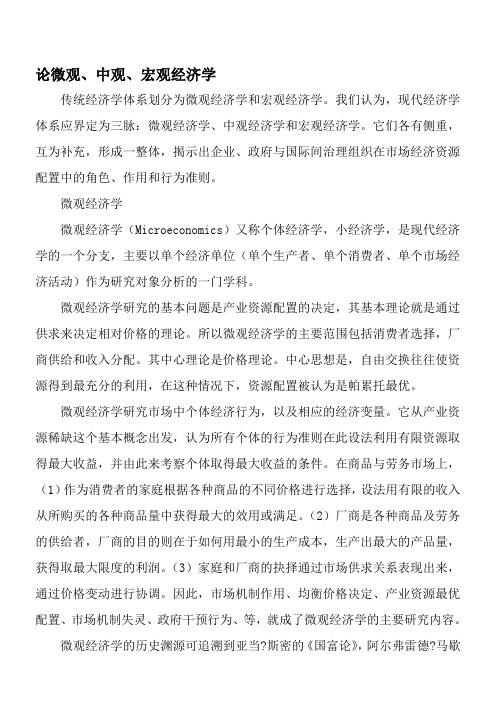
论微观、中观、宏观经济学传统经济学体系划分为微观经济学和宏观经济学。
我们认为,现代经济学体系应界定为三脉:微观经济学、中观经济学和宏观经济学。
它们各有侧重,互为补充,形成一整体,揭示出企业、政府与国际间治理组织在市场经济资源配置中的角色、作用和行为准则。
微观经济学微观经济学(Microeconomics)又称个体经济学,小经济学,是现代经济学的一个分支,主要以单个经济单位(单个生产者、单个消费者、单个市场经济活动)作为研究对象分析的一门学科。
微观经济学研究的基本问题是产业资源配置的决定,其基本理论就是通过供求来决定相对价格的理论。
所以微观经济学的主要范围包括消费者选择,厂商供给和收入分配。
其中心理论是价格理论。
中心思想是,自由交换往往使资源得到最充分的利用,在这种情况下,资源配置被认为是帕累托最优。
微观经济学研究市场中个体经济行为,以及相应的经济变量。
它从产业资源稀缺这个基本概念出发,认为所有个体的行为准则在此设法利用有限资源取得最大收益,并由此来考察个体取得最大收益的条件。
在商品与劳务市场上,(1)作为消费者的家庭根据各种商品的不同价格进行选择,设法用有限的收入从所购买的各种商品量中获得最大的效用或满足。
(2)厂商是各种商品及劳务的供给者,厂商的目的则在于如何用最小的生产成本,生产出最大的产品量,获得取最大限度的利润。
(3)家庭和厂商的抉择通过市场供求关系表现出来,通过价格变动进行协调。
因此,市场机制作用、均衡价格决定、产业资源最优配置、市场机制失灵、政府干预行为、等,就成了微观经济学的主要研究内容。
微观经济学的历史渊源可追溯到亚当?斯密的《国富论》,阿尔弗雷德?马歇尔的《经济学原理》。
20世纪30年代以后,英国的罗宾逊和美国的张伯伦在马歇尔的均衡价格理论基础上,提出了厂商均衡理论。
标志着微观经济学体系最终确立的内容主要包括:均衡价格理论,消费者行为理论,生产者行为理论,厂商均衡理论和福利经济学等。
宏观经济学术语(中英文对照)
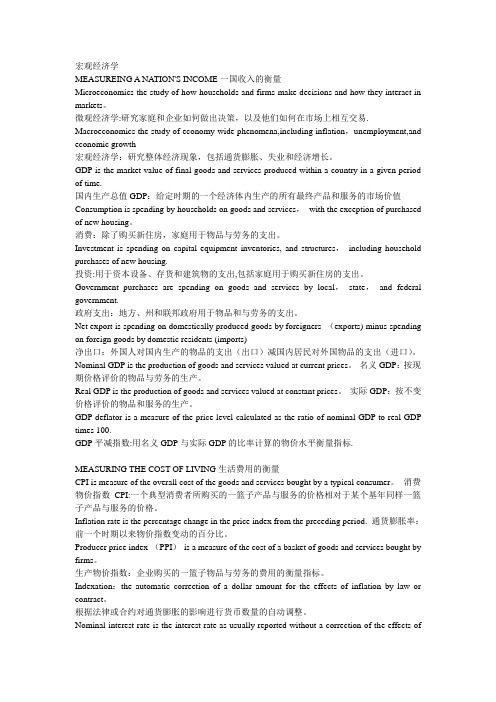
MEASUREING A NATION'S INCOME一国收入的衡量Microeconomics the study of how households and firms make decisions and how they interact in markets。
微观经济学:研究家庭和企业如何做出决策,以及他们如何在市场上相互交易. Macroeconomics the study of economy-wide phenomena,including inflation,unemployment,and economic growth宏观经济学:研究整体经济现象,包括通货膨胀、失业和经济增长。
GDP is the market value of final goods and services produced within a country in a given period of time.国内生产总值GDP:给定时期的一个经济体内生产的所有最终产品和服务的市场价值Consumption is spending by households on goods and services,with the exception of purchased of new housing。
消费:除了购买新住房,家庭用于物品与劳务的支出。
Investment is spending on capital equipment inventories, and structures,including household purchases of new housing.投资:用于资本设备、存货和建筑物的支出,包括家庭用于购买新住房的支出。
Government purchases are spending on goods and services by local,state,and federal government.政府支出:地方、州和联邦政府用于物品和与劳务的支出。
宏观与微观经济学的区别和联系

宏观与微观经济学的区别和联系微观研究对象是个体经济单位:单个消费者、单个生产者、单个市场。
一共分为两个市场:产品市场和生产要素市场。
消费者对产品有需求(微观中的效用问题)企业提供的产品供给(生产论和成本论),这两样在产品市场得到均衡。
而企业要想提供供给就需要在要素市场购买要素,企业转为需求方而消费者则是要素的供给方,这两样又在要素市场寻求均衡。
说白了就是一个循环,我提供劳力赚钱买东西,企业卖东西得到钱用来买劳力进行生产。
微观大致就说这些,后面还有一般均衡和市场失灵,就是讲两个市场同时均衡的问题。
宏观研究的是社会总体的行为及后果。
主要研究四个方面:就业,物价,经济增长,国际收支。
从产品市场,货币市场和国际市场进行的研究。
联系嘛:微观是基础,先有的微观再有的宏观。
他俩是局部和总体的关系经济模型可以用于分析许多领域的决策。
我们把有些领域归入微观经济学中,而把其他领域归入宏观经济学中。
微观经济学(microeconomics)研究家庭和企业如何做出选择,它们如何在市场上相互作用,以及政府如何试图影响它们的选择。
微观经济学问题包括解释消费者如何应对产品价格的变化以及企业如何决定收取什么样的价格。
微观经济学还涉及到政策问题,如分析减少未成年人吸烟的最有效方法,分析批准销售一种新处方药的成本和收益,以及分析降低空气污染的最有效方法。
宏观经济学(macroeconomics)研究作为整体的经济,包括诸如通货膨胀、失业和经济增长这样一些问题。
宏观经济学问题包括解释为什么经济会经历衰退和失业不断增加的时期,以及为什么在长期内有些经济体比其他经济体增长得快得多。
宏观经济学也涉及政策问题,如政府干预能否降低衰退的严重性。
微观经济学和宏观经济学之间的区分并不是严格且固定不变的。
许多经济情况既涉及微观经济也涉及宏观经济的层面。
例如,企业投资于新机器和设备的总体水平有助于确定经济增长的速度—这是一个宏观经济问题。
但要了解企业决定购买多少新的机器设备,我们又需要分析单个企业所面临的激励—而这是一个微观经济问题。
宏微观经济学名词解释英语

宏微观经济学名词解释英语Macroeconomics and Microeconomics TerminologyMacroeconomics:1. Aggregate Demand (AD): The total demand for all goods and services in an economy at a given time and price level.2. Aggregate Supply (AS): The total supply of all goods and services in an economy at a given time and price level.3. Business Cycle: The periodic fluctuations in economic activity, measured by variables such as GDP, employment, and inflation.4. Fiscal Policy: The use of government spending and taxation to influence the economy.5. Gross Domestic Product (GDP): The total market value of all final goods and services produced within a countryin a given period.6. Inflation: The sustained increase in the generalprice level of goods and services in an economy over time.7. Monetary Policy: The actions taken by a central bank, such as the Federal Reserve, to influence the money supply and interest rates to achieve economic objectives.8. Recession: A period of temporary economic decline, generally identified by a fall in GDP for two consecutive quarters.9. Unemployment: The state of being without a job, actively seeking employment, and available for work.Microeconomics:1. Demand: The willingness and ability of consumers to purchase a good or service at different prices.2. Supply: The willingness and ability of producers to offer a good or service for sale at different prices.3. Equilibrium Price: The price at which the quantity demanded equals the quantity supplied.4. Elasticity: A measure of the responsiveness of one variable to changes in another variable.5. Marginal Cost: The additional cost of producing one more unit of a good or service.6. Marginal Revenue: The additional revenue earned from selling one more unit of a good or service.7. Opportunity Cost: The value of the next bestalternative that must be forgone to pursue a certain action.8. Perfect Competition: A market structure characterized by many small firms selling identical products, with no individual firm having the ability to influence the market price.9. Monopoly: A market structure with a single seller ofa product for which there are no close substitutes.10. Externality: A cost or benefit that affects a party who did not choose to incur that cost or benefit.宏观经济学和微观经济学术语宏观经济学:1. 总需求(AD):在某一时间和价格水平下,经济中所有商品和服务的总需求。
经济管理及财务知识分析词汇

经济管理及财务知识分析词汇经济管理相关词汇1.市场经济(Market Economy):一种经济系统,由供求关系决定价格和资源配置,政府对经济活动的干预较少。
2.社会主义市场经济(Socialist Market Economy):中国特色的经济制度,基于社会主义基本制度,发挥市场在配置资源方面的决定性作用。
3.宏观经济学(Macroeconomics):研究经济系统整体运行的经济学分支,关注国民经济的总体变化、经济增长、通货膨胀等宏观现象。
4.微观经济学(Microeconomics):研究个体经济代理人(如家庭、企业等)的行为和决策,以及市场机制的运作等,强调个体效用最大化。
5.经济周期(Economic Cycle):经济发展的周期性波动,包括繁荣、衰退、萧条和复苏等阶段。
6.边际效应(Marginal Effect):指在某一决策单位增加或减少一单位的资源或产品时,所引起的最后一单位变动对应的效果或成本。
7.供需关系(Supply and Demand):市场上供给和需求之间的关系,决定了产品的市场价格及数量。
8.经济增长(Economic Growth):国民经济总体产出(如国内生产总值(GDP))在一定时期内的增加。
9.毛利润(Gross Profit):销售收入减去直接成本(如原材料成本)后的余额,用于衡量企业的盈利能力。
10.税负(Tax Burden):纳税人在一定时期内所负担的各项税费的总和,包括直接税和间接税。
财务知识相关词汇1.会计准则(Accounting Standards):对企业会计信息采集、处理和报告的规范规定,旨在保证会计信息的真实、准确和可比性。
2.财务报表(Financial Statements):反映企业财务状况、经营成果和现金流量的报表,包括资产负债表、利润表和现金流量表。
3.资产负债表(Balance Sheet):反映企业在某一特定日期上的资产、负债和所有者权益的状况。
宏观经济学

宏观经济学起源二战以后,西方经济学家把经济学分为:宏观经济学(Macroeconomics)和微观经济学(Microeconomics)。
Macro来自希腊语,原意为“大”“宏大”,与Micro“微小相对应。
宏观经济学”属于理论经济学。
宏观经济学的特点1、以国名经济整体为研究对象2、采取总量分析的方法3、以市场机制有缺陷、政府可以弥补不足为前提微观经济学的假设前提是市场出清、完全理性和完全信息,认为市场这只“看不见的手”能够自我调节以实现市场的最优配置。
而宏观经济学的假设是市场这只“看不见的手”是有缺陷的,但政府有能力运用这只“看的见的手”来弥补市场机制的不足。
4、要解决的是资源利用的问题微观要解决的是资源配置问题,即生产什么,如何生产和为谁生产的问题。
厂商从要素市场上获得生产要素,生产出消费者需要的产品,由此,厂商实现利润最大化,消费者实现效用最大化。
而宏观是以国民收入(NI)决定为核心,研究现有资源为充分利用的原因和实现充分利用的途径,以及如何实现经济的长期增长等问题,从而实现社会福利最大化。
5、中心内容是国民收入决定理论微观的中心内容是价格决定理论,包括消费者行为理论、生产理论、成本理论、分配理论、一般均衡理论和市场理论。
而宏观的中心内容是国民收入决定理论,包括通货膨胀与通货紧缩理论、就业理论、经济周期理论、经济增长理论和宏观经济政策等。
宏观经济学的产生及发展1、宏观经济学历经的三个阶段萌芽:17世纪中叶到凯恩斯的《通论》发表以前——没有与微观严格的区分开来建立:《通论》发表至20世纪70年代——形成了完善的宏观经济体系发展:从20世纪70年代至今——由于凯恩斯主义无法解释“滞涨”现象,出现了以新自由主义为代表的宏观经济理论<经济滞涨——指经济萧条(失业)与通货膨胀并存的经济现象。
>2、创始人:威廉·配第William Petty重农主义学派代表人:弗朗索瓦·魁奈(F.Quesnay)古典经济学的代表人:亚当·斯密(Adam Smith)——提出《国富论》古典经济学的完成者:大卫·李嘉图(David Ricardo)马歇尔将古典经济学和边际效用论结合起来——形成:新古典经济学(以充分就业为前提,着力于研究资源的优化配置)1922-1933年的经济危机,凯恩斯对传统经济学彻底否定,被称为“凯恩斯革命”,现代宏观经济学诞生3凯恩斯革命体现在i.经济理论上的革命传统经济学信奉“萨伊定律”,认为:供给能够自动创造需求;储蓄永远等于投资(通过银行的作用,全部转为投资);通过市场机制的调节,资源能够充分利用;不存在非凯恩斯否定了伊萨定律,提出:有效需求创造供给;否定投资永远等于储蓄;否认传统的失业理论,承认非自愿失业的存在;强调必须依靠政府的力量对经济进行干预,才能避免经济衰退和失业。
高一英语经济理论单选题50题
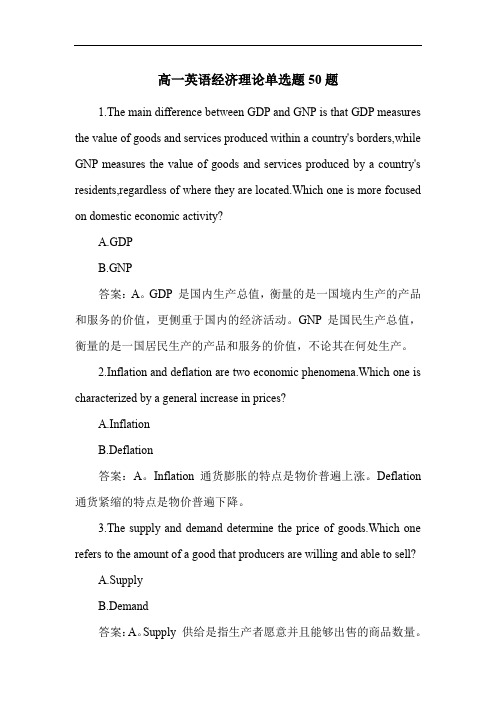
高一英语经济理论单选题50题1.The main difference between GDP and GNP is that GDP measures the value of goods and services produced within a country's borders,while GNP measures the value of goods and services produced by a country's residents,regardless of where they are located.Which one is more focused on domestic economic activity?A.GDPB.GNP答案:A。
GDP 是国内生产总值,衡量的是一国境内生产的产品和服务的价值,更侧重于国内的经济活动。
GNP 是国民生产总值,衡量的是一国居民生产的产品和服务的价值,不论其在何处生产。
2.Inflation and deflation are two economic phenomena.Which one is characterized by a general increase in prices?A.InflationB.Deflation答案:A。
Inflation 通货膨胀的特点是物价普遍上涨。
Deflation 通货紧缩的特点是物价普遍下降。
3.The supply and demand determine the price of goods.Which one refers to the amount of a good that producers are willing and able to sell?A.SupplyB.Demand答案:A。
Supply 供给是指生产者愿意并且能够出售的商品数量。
Demand 需求是指消费者愿意并且能够购买的商品数量。
经济与金融英语词汇大全

经济与金融英语词汇大全Abstract:本文旨在提供一份经济与金融英语词汇大全,旨在帮助读者扩展自己的金融英语词汇量,以更好地理解并应用于经济和金融领域。
本词汇大全涵盖了各个方面的经济与金融术语,并提供了简明的解释和示例,以确保读者能够准确有效地使用这些词汇。
1. 宏观经济学 (Macroeconomics)宏观经济学是研究整体经济的学科,涉及国民收入、就业、通货膨胀等方面的研究。
- Gross Domestic Product (GDP): 国内生产总值,衡量一国某一特定时期内所生产的所有最终产品和服务的市场价值。
- Unemployment Rate: 失业率,衡量劳动力中无工作而愿意就业的人的比例。
2. 微观经济学 (Microeconomics)微观经济学是研究个体经济单位(如家庭、公司)的学科,涉及供求、价格等方面的研究。
- Supply and Demand: 供求关系,在市场经济中决定产品和服务的价格和数量。
- Price Elasticity: 价格弹性,衡量供求关系对价格变化的敏感程度。
3. 财政学 (Public Finance)财政学是研究政府财政活动的学科,涉及税收、开支等方面的研究。
- Budget Deficit: 预算赤字,政府在一定时期内支出大于收入的情况。
- Taxation: 税收,政府向个人和企业征收的款项。
4. 国际贸易 (International Trade)国际贸易是国家之间商品和服务交流的过程,涉及进出口、贸易政策等方面的研究。
- Tariff: 关税,国家对进口商品征收的额外费用。
- Free Trade: 自由贸易,国家之间以最低限度或无限制地交换商品和服务。
5. 银行与金融机构 (Banking and Financial Institutions)银行与金融机构提供各种金融服务,如存款、贷款、投资等。
- Commercial Bank: 商业银行,从公众存款中募集资金,提供贷款和其他金融服务。
宏观经济学原理(第七版)曼昆 名词解释(带英文)
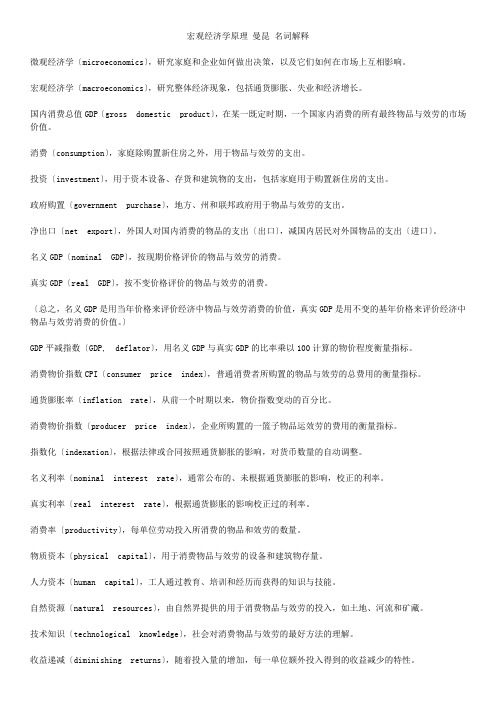
宏观经济学原理曼昆名词解释微观经济学〔microeconomics〕,研究家庭和企业如何做出决策,以及它们如何在市场上互相影响。
宏观经济学〔macroeconomics〕,研究整体经济现象,包括通货膨胀、失业和经济增长。
国内消费总值GDP〔gross domestic product〕,在某一既定时期,一个国家内消费的所有最终物品与效劳的市场价值。
消费〔consumption〕,家庭除购置新住房之外,用于物品与效劳的支出。
投资〔investment〕,用于资本设备、存货和建筑物的支出,包括家庭用于购置新住房的支出。
政府购置〔government purchase〕,地方、州和联邦政府用于物品与效劳的支出。
净出口〔net export〕,外国人对国内消费的物品的支出〔出口〕,减国内居民对外国物品的支出〔进口〕。
名义GDP〔nominal GDP〕,按现期价格评价的物品与效劳的消费。
真实GDP〔real GDP〕,按不变价格评价的物品与效劳的消费。
〔总之,名义GDP是用当年价格来评价经济中物品与效劳消费的价值,真实GDP是用不变的基年价格来评价经济中物品与效劳消费的价值。
〕GDP平减指数〔GDP, deflator〕,用名义GDP与真实GDP的比率乘以100计算的物价程度衡量指标。
消费物价指数CPI〔consumer price index〕,普通消费者所购置的物品与效劳的总费用的衡量指标。
通货膨胀率〔inflation rate〕,从前一个时期以来,物价指数变动的百分比。
消费物价指数〔producer price index〕,企业所购置的一篮子物品运效劳的费用的衡量指标。
指数化〔indexation〕,根据法律或合同按照通货膨胀的影响,对货币数量的自动调整。
名义利率〔nominal interest rate〕,通常公布的、未根据通货膨胀的影响,校正的利率。
真实利率〔real interest rate〕,根据通货膨胀的影响校正过的利率。
宏观经济学原理第七版曼昆名词解释带英文
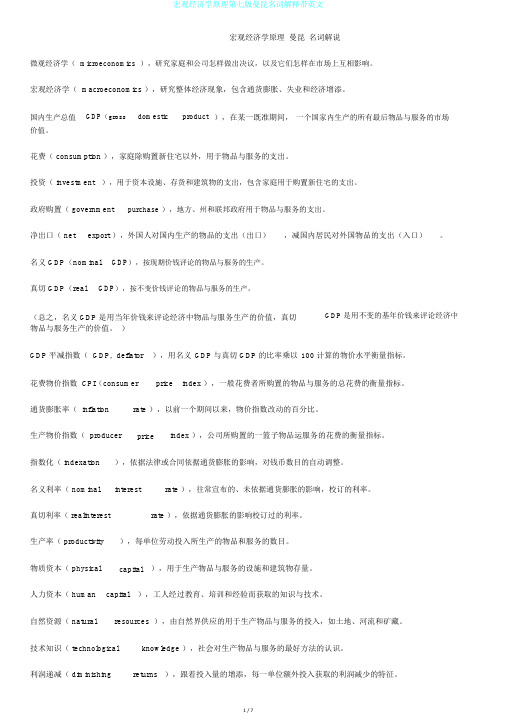
宏观经济学原理曼昆名词解说微观经济学( microeconomics ),研究家庭和公司怎样做出决议,以及它们怎样在市场上互相影响。
宏观经济学( macroeconomics ),研究整体经济现象,包含通货膨胀、失业和经济增添。
国内生产总值GDP(gross domestic product ),在某一既准期间,一个国家内生产的所有最后物品与服务的市场价值。
花费( consumption ),家庭除购置新住宅以外,用于物品与服务的支出。
投资( investment),用于资本设施、存货和建筑物的支出,包含家庭用于购置新住宅的支出。
政府购置( government purchase ),地方、州和联邦政府用于物品与服务的支出。
净出口( net export ),外国人对国内生产的物品的支出(出口),减国内居民对外国物品的支出(入口)。
名义 GDP(nominal GDP),按现期价钱评论的物品与服务的生产。
真切 GDP(real GDP),按不变价钱评论的物品与服务的生产。
GDP是用不变的基年价钱来评论经济中(总之,名义 GDP是用当年价钱来评论经济中物品与服务生产的价值,真切物品与服务生产的价值。
)GDP平减指数( GDP, deflator),用名义GDP与真切 GDP的比率乘以100 计算的物价水平衡量指标。
花费物价指数 CPI(consumer price index ),一般花费者所购置的物品与服务的总花费的衡量指标。
通货膨胀率( inflation rate ),以前一个期间以来,物价指数改动的百分比。
生产物价指数( producer price index ),公司所购置的一篮子物品运服务的花费的衡量指标。
指数化( indexation ),依据法律或合同依据通货膨胀的影响,对钱币数目的自动调整。
名义利率( nominal interest rate ),往常宣布的、未依据通货膨胀的影响,校订的利率。
宏微观经济学英文名词解释

宏微观经济学英文名词解释Macroeconomics and Microeconomics: Key Concepts Explained。
In the realm of economics, two fundamental branches govern the analysis and understanding of economic systems: macroeconomics and microeconomics. These disciplines delve into the intricate workings of economies, albeit from different perspectives. Below, we elucidate the key concepts in both macro and microeconomics, shedding light on their significance and how they shape our understanding of economic phenomena.Macroeconomics:。
1. Gross Domestic Product (GDP): GDP serves as a cornerstone indicator in macroeconomics, representing the total value of all goods and services produced within a country's borders over a specific period. It encapsulates the economic health and performance of a nation, reflecting its overall output and standard of living.2. Inflation: Inflation denotes the rate at which the general price level of goods and services rises over time. It erodes purchasing power and influences consumer behavior, investment decisions, and government policies. Central banks often target a specific inflation rate to maintain economic stability.3. Unemployment: Unemployment measures the proportion of the labor force actively seeking employment but unable to find jobs. It reflects underutilization of labor resources within an economy, impacting income distribution, social welfare, and government expenditure on welfare programs.4. Fiscal Policy: Fiscal policy pertains to the use of government spending and taxation to influence economic conditions. Governments employ fiscal measures to stimulate or restrain economic growth, manage inflation, and address unemployment through budgetary adjustments and public expenditure programs.5. Monetary Policy: Monetary policy involves the regulation of money supply and interest rates by central banks to achieve macroeconomic objectives. Through tools like open market operations and reserve requirements, monetary authorities aim to control inflation, stabilize currency value, and promote economic growth.Microeconomics:。
经济学专业书单

经济学专业书单经济学是研究资源配置和价值交换的学科,包括微观经济学和宏观经济学两个分支。
为了深入了解经济学的理论和应用,学习者需要阅读一些经济学专业书籍。
下面是一份经济学专业书单,涵盖了经济学的基础理论、方法和实际应用。
1. 《经济学原理》(Principles of Economics)- Mankiw该书是经济学入门的经典教材,涵盖了微观经济学和宏观经济学的基本原理。
它以清晰简洁的语言解释了经济学的核心概念和理论,并通过实际案例和数据分析展示了经济学在现实生活中的应用。
2. 《微观经济学》(Microeconomics)- Pindyck and Rubinfeld这本书详细介绍了微观经济学的理论和方法。
它解释了个体经济主体(如家庭、企业和市场)的行为决策,分析了价格、供求关系、市场结构和市场失灵等重要问题。
此外,书中还提供了大量的实际案例和数据,帮助读者理解经济学在现实世界中的应用。
3. 《宏观经济学》(Macroeconomics)- Blanchard这本教材介绍了宏观经济学的基本概念和理论,涵盖了国民经济总体规模、增长率、通货膨胀、失业率等重要经济指标的分析和解释。
书中还探讨了货币政策、财政政策和国际经济等宏观经济政策的制定和实施。
4. 《发展经济学》(Development Economics)- Todaro and Smith这本书介绍了发展经济学的理论和实践。
它探讨了发展中国家面临的经济问题和挑战,如贫困、失业、教育、卫生、环境等,并提供了解决这些问题的政策建议和经验教训。
5. 《国际经济学》(International Economics)- Krugman and Obstfeld该书系统地介绍了国际经济学的理论和实证研究。
它涵盖了国际贸易、国际金融和国际货币体系等重要主题,解释了国际贸易的原因和影响,以及国际金融市场的运作和政策。
6. 《实证经济学导论》(Introduction to Econometrics)- Stock and Watson这本书介绍了经济计量学的理论和应用。
Microeconomics and Macroeconomics 宏观经济与微观经济的区分以及案例分析教程文件

M i c r o e c o n o m i c sa n dM a c r o e c o n o m i c s宏观经济与微观经济的区分以及案例分析●Macroeconomics1. A branch of economics dealing with the performance, structure, behavior, and decision-making of an economy as a whole, rather than individual markets.2.Basic concepts:✓Output and income✓Unemployment✓Inflation and deflation.3.It studies aggregated indicators such as:✓GDP (gross domestic product): the market value of all officially recognized final goods and services produced within a country in a year, or other given period of time. GDP percapita is often considered an indicator of a country's standard of living.✓Unemployment rate:"Unemployed workers" are those who are currently not working but are willing and able to work for pay, currently available to work, and have actively searched for work.✓Price indexes:1. CPI (Consumer price index): measures changes in the price level of a marketbasket of consumer goods and services purchased by households. Goods listed in the CPI include food and beverages, transportation, housing, clothing, medical care, recreation, education and communication, and other goods and services.2. PPI (Producer price index): measures the average changes in prices received by domestic producers for their output.➢Macroeconomists develop models that explain the relationship between such factors as national income, output, consumption, unemployment, inflation, savings, investment,international trade and international finance.➢Macroeconomics policy:✓Monetary policy(interest rates)✓Fiscal policy (tax structure and government spending)●Microeconomics➢ A branch of economics that studies the behavior of individuals and small impacting players in making decisions on the allocation of limited resources.➢It applies to markets where goods or services are bought and sold. Microeconomics examines how these decisions and behaviors affect the supply and demand for goods and services,which determines prices, and how prices, in turn, determine the quantity supplied andquantity demanded of goods and services.➢It studies the topics as follows:✓Demand, supply, and equilibrium(market price): price is a market’s automatic regulator.✓Measurement of elasticities:✧The ratio of the percentage change in one variable to the percentage change inanother variable, when the latter variable has a causal influence on the former.✧Price elasticity of demand: a measure of the responsiveness of the quantitydemanded of a good to a change in its price when all other influences on buyers’plans remain the same.Percentage change in price=[(new price-initial price)/initial price]*100Percentage change in quantity=[(new quantity-initial quantity)/initial quantity]*100(-)<draw out the pics for each situation: 2 Yuan for each pic>Elastic demand: (dQ/Q)>(dP/P) or e>1Unit elastic demand: (dQ/Q)=(dP/P) or e=1Inelastic demand:(dQ/Q)<(dP/P) or e<1Perfectly elastic demand:(dQ/Q→∞)/(dP/P=0)Perfectly inelastic demand:dQ/Q=constantInfluences on the price elasticity of demand:1)availability of substitutes:Luxury VS necessity;Narrowness of definition;Time elapsed since price change2)proportion of income spent: the greater the proportion of income spent on a good,the greater is the impact of a rise in its price on the quantity of that good that peoplecan afford to buy and the more elastic is the demand for the good.✧price elasticity of supply (+) (for self learning)✧income elasticity of demand:>1 (normal good, income elastic)<1 (normal good, income inelastic)<0 (inferior good)✓Four elements of private enterprise: private property rights, freedom of choice, profits, and competition.✧Perfect competition: markets such that no participants are large enough to have the marketpower to set the price of a single product.✧Monopolistic competition: market or industry characterized by numerous buyers andrelatively numerous sellers trying to differentiate their products from those competitors.✧Monopoly: a single company is the only supplier of a particular commodity.✧Oligopoly: a market or industry is dominated by a small number of sellers (oligopolists).Four Different Types of Competition✓Game theory: the study of mathematical models of conflict and cooperation between intelligent rational decision-makers.Common Measures Used to Evaluate a Nation’s Economic Health。
- 1、下载文档前请自行甄别文档内容的完整性,平台不提供额外的编辑、内容补充、找答案等附加服务。
- 2、"仅部分预览"的文档,不可在线预览部分如存在完整性等问题,可反馈申请退款(可完整预览的文档不适用该条件!)。
- 3、如文档侵犯您的权益,请联系客服反馈,我们会尽快为您处理(人工客服工作时间:9:00-18:30)。
1. A branch of economics dealing with the performance, structure, behavior, anddecision-making of an economy as a whole, rather than individual markets.2.Basic concepts:✓Output and income✓Unemployment✓Inflation and deflation.3.It studies aggregated indicators such as:✓GDP (gross domestic product): the market value of all officially recognized final goods and services produced within a country in a year, or other given period of time. GDP percapita is often considered an indicator of a country's standard of living.✓Unemployment rate:"Unemployed workers" are those who are currently not working but are willing and able to work for pay, currently available to work, and have actively searched for work.✓Price indexes:1. CPI (Consumer price index): measures changes in the price level of a market basket of consumer goods and services purchased by households. Goods listed in the CPI include food and beverages, transportation, housing, clothing, medical care, recreation, education and communication, and other goods and services.2. PPI (Producer price index): measures the average changes in prices received by domestic producers for their output.➢Macroeconomists develop models that explain the relationship between such factors as national income, output, consumption, unemployment, inflation, savings, investment, international trade and international finance.➢Macroeconomics policy:✓Monetary policy(interest rates)✓Fiscal policy (tax structure and government spending)➢ A branch of economics that studies the behavior of individuals and small impacting players in making decisions on the allocation of limited resources.➢It applies to markets where goods or services are bought and sold. Microeconomics examines how these decisions and behaviors affect the supply and demand for goods and services, which determines prices, and how prices, in turn, determine the quantity supplied and quantity demanded of goods and services.➢It studies the topics as follows:✓Demand, supply, and equilibrium(market price): price is a market’s automatic regulator.✓Measurement of elasticities:✧The ratio of the percentage change in one variable to the percentage change inanother variable, when the latter variable has a causal influence on the former.✧Price elasticity of demand: a measure of the responsiveness of the quantitydemanded of a good to a change in its price when all other influences on buyers’plans remain the same.Percentage change in price=[(new price-initial price)/initial price]*100Percentage change in quantity=[(new quantity-initial quantity)/initial quantity]*100(-)<draw out the pics for each situation: 2 Yuan for each pic>Elastic demand: (dQ/Q)>(dP/P) or e>1Unit elastic demand: (dQ/Q)=(dP/P) or e=1Inelastic demand:(dQ/Q)<(dP/P) or e<1Perfectly elastic demand:(dQ/Q→∞)/(dP/P=0)Perfectly inelastic demand:dQ/Q=constantInfluences on the price elasticity of demand:1)availability of substitutes:Luxury VS necessity;Narrowness of definition;Time elapsed since price change2)proportion of income spent: the greater the proportion of income spent on a good,the greater is the impact of a rise in its price on the quantity of that good that peoplecan afford to buy and the more elastic is the demand for the good.✧price elasticity of supply (+) (for self learning)✧income elasticity of demand:>1 (normal good, income elastic)<1 (normal good, income inelastic)<0 (inferior good)✓Four elements of private enterprise: private property rights, freedom of choice, profits,and competition.✧Perfect competition: markets such that no participants are large enough to have the marketpower to set the price of a single product.✧Monopolistic competition: market or industry characterized by numerous buyers andrelatively numerous sellers trying to differentiate their products from those competitors.✧Monopoly: a single company is the only supplier of a particular commodity.✧Oligopoly: a market or industry is dominated by a small number of sellers (oligopolists).Four Different Types of Competition✓Game theory: the study of mathematical models of conflict and cooperation between intelligent rational decision-makers.Common Measures Used to Evaluate a Nation’s Economic Health。
